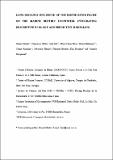Por favor, use este identificador para citar o enlazar a este item:
http://hdl.handle.net/10261/180249COMPARTIR / EXPORTAR:
 SHARE SHARE
 CORE
BASE CORE
BASE
|
|
| Visualizar otros formatos: MARC | Dublin Core | RDF | ORE | MODS | METS | DIDL | DATACITE | |

| Título: | Long-distance influence of the Rhône River plume on the marine benthic ecosystem: Integrating descriptive ecology and predictive modelling |
Autor: | Martin, Daniel CSIC ORCID CVN ; Pititto, Francesco CSIC; Gil, João CSIC ORCID ; Mura, Maria Paola CSIC ORCID ; Bahamon, Nixon CSIC ORCID ; Romano, Chiara CSIC ORCID ; Thorin, Sébastien; Schvartz, Thibault; Dutrieux, Eric; Bocquenet, Yannick | Palabras clave: | Benthic ecosystems River discharges Descriptive ecology Species distribution models |
Fecha de publicación: | jul-2019 | Editor: | Elsevier | Citación: | Science of the Total Environment 673: 790-809 (2019) | Resumen: | The Gulf of Lions (GoL) is among themost productive areas of theMediterranean Sea, with the Rhône River contributingwith asmuch as 90% of the liquid and solidmaterials (including anthropogenic chemicals) reaching the area. In this paper, we assessed whether classical descriptive ecology and MaxEnt predictive species distribution modelling were able to provide complementary information when analysing the long-distance influence of the river discharges on the GoL benthic ecosystem. Sampleswere collected in August 2014 from 12 stations covering the sedimentary plain of the deep submarine delta, from the Gulf of Fos to Gruissan. Sediments were mostly muddy with a high organic carbon and low P and N contents first decreasing and then increasing from east to west. The same pattern occurred for chlorophyll-a, particulate organic carbon and sea surface temperature, andwas overall correlatedwithmetal and pollutant contents derived fromagricultural, port, urban and industrial sources driven by Rhône outputs. We observed a typical deltaic succession in the benthos, showing a relatively low diversity and including polychaetes (Sternaspis scutata) and holothurians (Oestergrenia digitata) known to be indicators of high sedimentation rates. Overall, benthos showed an inversed pattern regarding environmental variables, an evident consequence of the Rhône River influence. The suitability of some species was either positively or negatively correlated with some of the environmental variables, producing species-specific predicted distribution patterns,with the highest amount of information allowing to predict distributions being mainly provided by organic pollutants. Evenwith a limited number of available samples, our integrated approach reveals to be a very robust tool to highlight hidden patterns and contributes to improve our knowledge on how rivermediated anthropogenic discharges may influence biodiversity distribution and functional patterns in marine benthic ecosystems. | Descripción: | Este artículo contiene 20 páginas, 11 figuras, 8 tablas. | Versión del editor: | https://doi.org/10.1016/j.scitotenv.2019.04.010 | URI: | http://hdl.handle.net/10261/180249 | DOI: | 10.1016/j.scitotenv.2019.04.010 | ISSN: | 0048-9697 | E-ISSN: | 1879-1026 |
| Aparece en las colecciones: | (CEAB) Artículos (ICM) Artículos |
Ficheros en este ítem:
| Fichero | Descripción | Tamaño | Formato | |
|---|---|---|---|---|
| Martin et al 2019 Postprint.pdf | 3,38 MB | Adobe PDF |  Visualizar/Abrir |
CORE Recommender
SCOPUSTM
Citations
4
checked on 18-abr-2024
WEB OF SCIENCETM
Citations
4
checked on 28-feb-2024
Page view(s)
397
checked on 23-abr-2024
Download(s)
403
checked on 23-abr-2024
Google ScholarTM
Check
Altmetric
Altmetric
NOTA: Los ítems de Digital.CSIC están protegidos por copyright, con todos los derechos reservados, a menos que se indique lo contrario.
